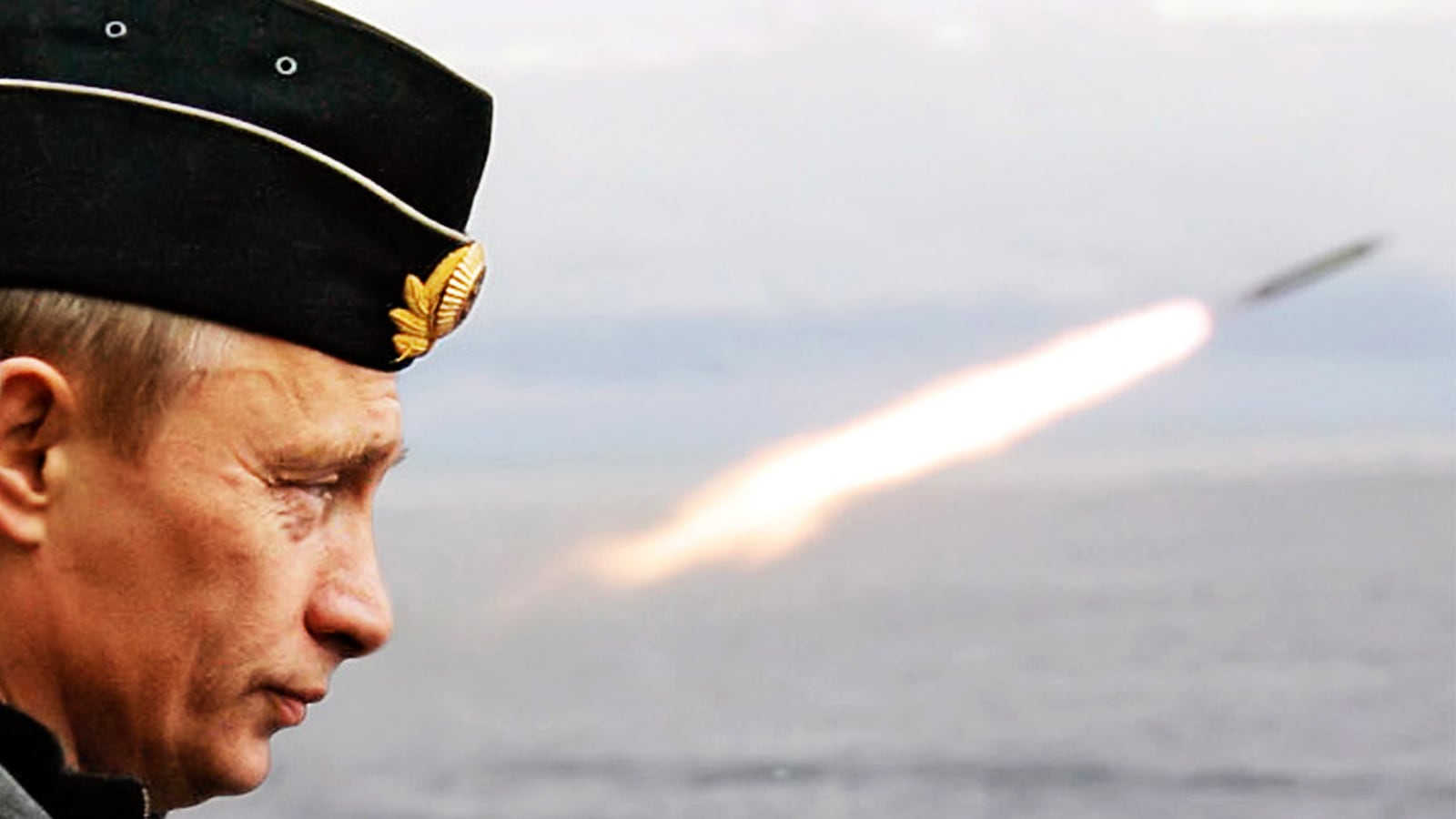MOSCOW—Russian President Vladimir Putin frequently boasts about this country’s new hypersonic nuclear weapons, intercontinental missiles capable of flying 20 times faster than the speed of sound. The Russian leader reminds the world again and again that because of these weapons no anti-missile system can deprive Russia of its military power, simply because nobody has “invincible” missiles as fast as Russia’s and nobody else has its secret technology.
But when Putin praises the scientists who design the rockets he neglects to mention that some of the most brilliant minds behind Russian hypersonic research are behind bars, under investigation for treason and accused of leaking secrets to foreign colleagues now classified as enemies of the Motherland.
At a meeting with top military officials last Wednesday, Putin spoke about a test launch of “Avangard,” a mobile hypersonic missile system. Putin described it as “a big success and victory,” promising delivery of the new strategic missile system to the military in early 2019.
Russian news agencies reported that the missile was fired from the Dombarovsky missile base in the Ural mountains and successfully hit the target in Kamchatka, 6,000 kilometers (about 3,700 miles) away.
“It was hard and time-consuming work which required breakthrough solutions in principal areas, and all this was done by our scientists, designers and engineers,” Putin said.
What’s this super-weapon all about?
Avangard is what the U.S. military calls a “hypersonic glide vehicle.” Propelled to high speed by the same kind of rocket that boosts a satellite or an intercontinental-range nuclear warhead, a hypersonic glide vehicle follows a different kind of flight path than other payloads do. Staying relatively close to Earth—reportedly around 300,000 feet up (about 91,000 meters), just below where the atmosphere ends and where space begins—the hypersonic vehicle glides toward its target at many times the speed of sound, potentially performing small maneuvers en route.
In theory a hypersonic glide vehicle can carry a conventional explosive warhead, a nuclear warhead or no warhead at all, instead relying on sheer kinetic force to destroy its target. Its low altitude and high maneuverability compared to a traditional intercontinental ballistic missile could make it harder to intercept. But ICBMs already are capable of blasting through normal defenses. The United States and Russia both possess missile-interceptors they claim can hit incoming ICBMs, but experts question the interceptors’ effectiveness against such fast targets.
In that sense, a nuclear-armed hypersonic glide vehicle offers few advantages over an older ICBM, which is one reason why the United States’ own military hypersonics research has focused on developing non-nuclear, high-speed weapons. But hypersonic glide vehicles also are unreliable owing to the heat and stress of super-fast flight. Around half of the Pentagon’s hypersonic flight tests have ended in unplanned crashes. Russia has experienced its own, similar difficulties refining hypersonic weapons.
All that said, Russia’s purported new hypersonic weapon is provocative, even if it doesn’t necessarily alter the nuclear balance of power, or work very well at all. And it is not surprising, especially amid the mounting tensions with NATO in recent years, that Russia would want to guard jealously its hypersonic secrets.
The Federal Security Service, FSB, suspects at least 10 employees of Roskosmos, the Russian state space agency, of leaking top secrets about hypersonic weapons to NATO.
Earlier this year the state security agency raided Roskosmos subsidiary, the Central Research Institute of Machine Building—or TsNIIMash—and arrested one of its leading specialists, Viktor Kudryavtsev. The charges against him accused him of passing to a NATO country technical information related to hypersonic technology used in the Kh-47M2 “Kinzhal” (“Dagger”), a nuclear-capable air-launched ballistic missile deployed to bases in Russia’s Southern Military District a year ago, and “Avangard,” the system tested this Wednesday.
Kudryavtsev’s lawyer, Ivan Pavlov, said that of all state treason cases he had worked on, this case was “the most outrageous.” Kudryavtsev, an emaciated man with a failing heart, is facing up to 20 years in prison for sending two emails to his European colleagues.
Last week two FSB investigators and several uniformed officials with faces covered in black masks rushed the 75-year-old scientist up to the fifth floor of the Lefortovo court. Pavlov told The Daily Beast that the FSB subjected Kudryavtsev to “unusually abusive and harmful treatment.” The scientist, looking ill, sat on a bench in his metal cage in the courtroom, apparently suffering from chest pain.
One year before his own arrest, Kudryavtsev had campaigned for the freedom of his colleague at TsNIIMash, 76-year-old spacecraft designer Vladimir Lapygin, who had been sentenced to seven years in a high-security prison for alleged treason leaking to the Chinese “a software system able to compute optimized aerodynamic characteristics of hypersonic aircraft containing state secrets.”
During Lapygin’s 2016 court hearing he testified that he had shared only an introductory copy of the software, intending to negotiate a contract between TsNIIMash and Chinese partners.
All this takes place against the background of a dramatically changed international situation since Russia’s annexation of the Crimean Peninsula and the launch of a Moscow-backed insurrection in Ukraine in 2014 precipitated what has taken shape as a new Cold War.
Back in 2003, the Russian government rewarded Kudryavtsev, a scientist with more than four decades of experience in space industry, for his work on the multinational Sea Launch space program. During the re-set years, when U.S. President Barack Obama and Russian President Dmitry Medvedev looked forward to joint security projects, Kudryavtsev was curating international hypersonic research approved by the Kremlin (PDF).
“Kudryavtsev is in jail for sending two emails concerning the TransHyBeriAN project,” Pavlov said.
The acronym stands, roughly, for the very technical “Characterization of Wall Temperature Effect during Transition of Hypersonic flow over a Cone By Experiments And Numerical Simulations.” It was a joint project between Russia and the Belgium-based Von Karman Institute for Fluid Dynamics with an overall budget of €651,373, of which the European Union put up €499,999. It began in 2011 and issued its final report in 2013 noting the results obtained were “an important contribution to the aerospace community (ESA and ROSCOSMOS) to maintain the scientific competitiveness with other countries.”
But since Kudryavstev’s arrest, Pavlov tells The Daily Beast, “Everybody, including the Von Karman Institute, have turned their backs on him, terrified by Russia and the ‘state treason’ case.”
Pavlov says the FSB put enormous pressure on Kudryavtsev to testify against yet another colleague in its crosshairs, but “he refuses to make the deal with the investigation, which is a heroic action, considering his health situation.”
When the Soviet Union fell apart, an estimated 15,000 to 30,000 physicists knowledgeable about nuclear weapons remained in the field. Many of them had worked in secret institutions, so-called “post office boxes,” which did not have any official address, just a POB number, and they did not have any right to travel.
Is Putin’s strategy aiming to keep scientists and their secrets at home once again?
Boris Shtern, a physicist at the Russian Academy of Sciences Institute for Nuclear Research, believes that Kudryavtsev was innocent. “They just picked him up to be their victim; and he is not the last one,” Shtern said. “In Soviet times the KGB was just standing over you for control, creating a complicated bureaucracy, but I cannot remember them putting random people in prison.”
With nuclear saber-rattling, Putin intends to send a message to domestic audiences that the country is powerful, surrounded by enemies; and to foreign audiences a reminder that Russia should be dealt with as a nuclear power.
“Russian state institutions, including the Foreign Ministry and the Defense Ministry, have lists of secrets, which are also secret, so scientists often have no idea what they are not supposed to speak about,” Pavlov said. “Kudryavtsev could not know back in 2013, when the government approved his research with foreign partners, that the Von Karman Institute would become a number one enemy.”
Meanwhile tensions continue to rise, with U.S. President Donald Trump threatening to withdraw from two different arms control treaties because of alleged Russian cheating.
“I am very worried about Trump withdrawing from nuclear arms treaties on the one hand and Putin rattling with his hypersonic rockets on the other,” Alexander Golts, an independent military expert, told The Daily Beast. “It seems people stopped being afraid of the real war, of nuclear winter.”
It’s not enough that Russia’s president seems unconcerned about a new cold war and arms race, he’s encouraging Russian citizens to feel happy about the increasingly scary arsenal of new rockets.
Last Wednesday, Putin was sitting between Gen. Valery Gerasimov, the chief of the General Staff, and Gen. Sergey Shoigu, Russia’s defense minister, watching the “Avangard” hypersonic glide vehicle on a big screen in the control room of Russian Defense Ministry in downtown Moscow when he exulted: “This is a wonderful, excellent New Year's present for our country.”









